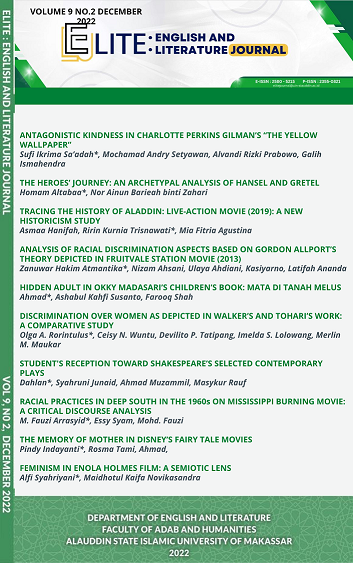THE HEROES’ JOURNEY: AN ARCHETYPAL ANALYSIS OF HANSEL AND GRETEL
Abstract
There are numerous fairy tales in the European tradition, and especially in the Grimms’ collection, that employ numerous archetypal themes, characters and motifs. This is true of the popular story, Hansel and Gretel. The examination of archetypes can be a laborious task given their rich psychological and cultural significance and their widespread use among seemingly distinct civilizations and genres. Accordingly, this study analyses the use of archetypes in the Grimms’ collection - through the example of Hansel and Gretel - to explore their full significance as these archetypes could potentially be a reason behind the enduring popularity of this story and the collection in general. The methodology of this study is based on the archetypal stages of the hero’s journey or quest as elaborated by Joseph Campbell in his seminal work, The Hero with a Thousand Faces. This study has concluded that Hansel and Gretel skilfully employ numerous archetypal elements such as the evil women, order versus chaos, thresholds and helpers, and the trickster and the witch within the archetypal framework of a hero's journey to allow its protagonists to achieve psychological and moral maturity and material rewards. Through its few pages, Hansel and Gretel offers readers rich moral lessons about courage, regression, shrewdness, loyalty, evil, compassion and destiny through the use of the archetypal journey and its various elements.
Keywords: Archetypes, fairytales, Hansel and Gretel, hero’s journey
Downloads
References
Anderson, G. (2000). Fairytale in the ancient world. Routledge.
Audi, R. (1999). Cambridge dictionary of philosophy. Cambridge University Press.
Baldick, C. (2001). The concise Oxford dictionary of literary terms. Oxford University Press.
Bettelheim, B. (2010). The uses of enchantment: The meaning and importance of fairy tales. Vintage Books.
Brunel, P. (1996). Companion to literary myths, heroes, and Archetypes. Routledge.
Campbell, J. (2004). Heroes with a thousand faces. Princeton University Press.
Chirila, A. (2010). Archetypal Criticism. In M. Ryan (Ed). The encyclopedia of literary and cultural theory (1st ed., 1, pp. 41-51). Wiley-Blackwell.
Cirlot, J. E. (2001). A dictionary of symbols (e-book ed.). Taylor & Francis e-Library.
Cotterell, A. (2006). Encyclopedia of mythology. Hermes House.
Cuddon, J. A. (1999). The Penguin Dictionary of literary terms and literary theory. Penguin Books.
Denecke, L. (n.d.). Brothers Grimm | Biography, Stories, & Works. Encyclopedia Britannica. https://www.britannica.com/biography/Brothers-Grimm
Doig, A. (2022). This mortal coil: A history of death. Bloomsbury.
English Standard Version Bible. (2001). ESV Online. https://esv.literalword.com/
Ferber, M. (1999). A dictionary of literary symbols. Cambridge University Press.
Frye, N. (1957). Anatomy of criticism. Princeton University Press.
Gatricya, R. (2014). The archetypes of hero and hero’s journey in five Grimm’s fairy tales. Yogyakarta State University.
Haase, D. (2008). The Greenwood encyclopedia of folktales and fairy tale. Greenwood Press.
Heidi, S [Tedx Talk]. (2018, May 24). Myths, Folklore & Legends: We Still Need Our Fairy Tales | Heidi Shamsuddin | TEDxUniversityofMalaya [Video]. YouTube. https://www.youtube.com/watch?v=5HlBwSYjUPI
Jung, C. G. (2004). Four archetypes: Mother, rebirth, spirit, trickster. Taylor & Francis e-Library.
Mohamad A. Q., & Rosli, T. (2000). Dictionary of literary terms revised edition. Prentice Hall.
Murphy, G. R. (2000). The owl, the raven, and the dove: the religious meaning of the Grimms' magic fairy tales. Oxford university Press.
O Grada, C. (2009). Famine: A short history. Princeton University Press.
Payne, M., & Barbera J. R. (2010). A dictionary of cultural and critical theory second edition. Wiley-Blackwell.
Peterson, J. B. (2002). Maps of meaning. Routledge.
Quinn, E. (2006). A dictionary of literary and thematic terms. Facts on File.
Serman, J. (2008). Storytelling: An encyclopedia of mythology and folklore. Sharpe Reference.
Silva, R. S. (2012). Fairy tales and moral value: A corpus-based approach. BELT Journal, 3(1), pp. 133-145. https://revistaseletronicas.pucrs.br/ojs/index.php/belt/article/view/10326
Sorea, D. (2018). The role of fairy tales in the self-realization process. In A. Repanovici, M. Koukourakis, T. Khecyoyan (Eds), Book power in communication. Trivent Publishing.
Tatar, M. (2015). The Cambridge companion of fairy tales. Cambridge University Press.
Tatar, M. (2019). The hard facts on Grimms fairy tales expanded edition. Princeton University Press.
Teverson, A. (2013). Fairy tale. Routledge.
Teverson, A. (2019). The fairy tale world. Routledge.
VandenBos, G. R. (2015). APA dictionary of psychology. American Psychological Association.
Zipes, J. (2000). The Oxford companion to fairy tales United States. Oxford University Press.
Zipes, J. (2012). A fairy tale is more than just a fairy tale, Book 2.0, 2(1), pp. 113-120. doi: 10.1386/btwo.2.1-2.113_1
Copyright (c) 2022 Homam altabaa, NOR AINUN BARIEAH BINTI ZAHARI

This work is licensed under a Creative Commons Attribution-NonCommercial-ShareAlike 4.0 International License.
Once an article was published in the journal, the author(s) are:
granted to the journal right licensed under Creative Commons License Attribution that allows others to share the work with an acknowledgement of the work's authorship.
permitted to publish their work online in third parties as it can lead wider dissemination of the work.
continue to be the copyright owner and allow the journal to publish the article with the CC BY-NC-SA 4.0 license
receiving a DOI (Digital Object Identifier) of the work.


